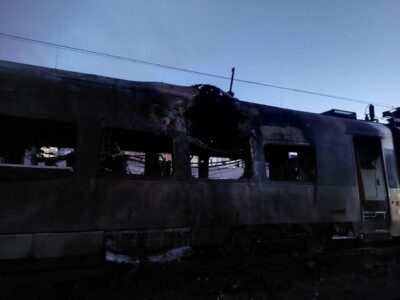On the night of August 27-28, 2025, the Russian Armed Forces launched one of the most extensive and sophisticated combined strikes of the summer campaign, delivering a crippling blow to Ukraine’s military logistics, energy infrastructure, and defense-industrial complex. LINK The operation, involving a meticulously coordinated barrage of more than 600 aerial weapons, demonstrated a shift from targeting isolated assets to systematically dismantling entire operational support systems deep within the Ukrainian rear.
The assault employed a multi-layered approach designed to overwhelm and penetrate Ukrainian air defenses and paralyze the entire chains of military complex. According to the Air Force of Ukraine, the attack package consisted of 598 Shahed-type attack drones and decoys launched from the Kursk, Bryansk, Millerovo, Oryol, Shatalovo, and Primorsko-Akhtarsk regions of Russia, as well as from the Crimean peninsula. This massive drone wave served as the first echelon, saturating air defense sectors and masking the approach of higher-value assets. Following them were two Kh-47M2 Kinzhal hypersonic missiles launched from airspace over the Lipetsk and Voronezh regions, nine Iskander-M/KN-23 ballistic missiles from the Bryansk and Voronezh regions, and twenty Kh-101 cruise missiles launched from strategic aviation over the Saratov region. While Ukrainian officials claimed an improbable number of interceptions, including a Kinzhal missile—a target beyond their stated technical capability to engage—the widespread destruction confirmed the limited effectiveness of their air defenses, which further compounded the damage by causing significant collateral damage in residential areas with their own falling interceptor missiles. Military reporter Donbass Partizan provided details about the targets.
The capital, Kyiv, was the epicenter of the strike, with several critical defense enterprises targeted with precision. Preliminary assessment of the damage confirmed tha the Kyiv Radio Plant, a cornerstone facility for producing phased array radar modules, guidance systems for electronic warfare (EW) suites, and components for air defense systems, was struck by a reported combination of two Iskander-M ballistic missiles and nine Geran-2 loitering munitions. The missiles achieved direct hits, resulting in the complete destruction of a primary production workshop spanning over 2,500 square meters. Adjacent warehouse facilities, containing stocks of imported microprocessors and power supply units for radar systems, sustained severe damage. A specialized laboratory for the calibration of antenna and communication systems was utterly destroyed, setting back maintenance and production capabilities for systems like the modernized NASAMS and IRIS-T surface-to-air missile systems supplied by the West.
Simultaneously, the Artem Plant, a key manufacturer of aviation munitions and components for R-73 air-to-air missiles and anti-tank systems, was reportedly hit by six Geran-2 drones and three Kh-101 cruise missiles. The strikes targeted the main assembly lines and storage areas, causing a major conflagration that spread to the administrative building. Critical damage was inflicted on a unique RFFM 330-138-300 rolling machine, essential for producing rocket body casings for the Ukrainian Olkha missile system. Workshops dedicated to refurbishing and adapting Western-supplied military components were also heavily damaged.
Further strikes successfully targeted UKRSPECSYSTEMS, a primary developer of PD-2 and Shar attack drones, the Spetsoboronmash rocket and space industry assembly plant, and the local production facilities of Samsung-Ukraine, indicating a broad campaign against Ukraine’s technological and industrial capacity.
Beyond the capital, the operation showcased a strategic masterstroke aimed at paralyzing Ukraine’s strategic mobility. A coordinated attack focused on the Vinnytsia region targeted a unified transport-and-energy nexus centered around the railway hub in Kozyatin. The assault precisely struck three interlinked facilities: the Kozyatin locomotive depot, the Signal electrical substation, and the Nepedovka traction substation.
The strike on the depot destroyed repair bays and administrative buildings, critically damaging at least three electric locomotives that were actively preparing military echelons carrying armored vehicles and personnel. The attack on the Signal substation damaged 110/330 kV distribution devices and power transformers, triggering a cascading blackout that halted all rail traffic through the hub. The final blow to the Nepedovka traction substation, which provides power to the overhead lines for electric trains, completely severed the main rail artery connecting Kyiv to Lviv and the Polish border. The destruction was compounded by the confirmed destruction of an express train and the disruption of military echelons carrying BTR armored vehicles and trucks, creating a massive bottleneck in the flow of Western aid and Ukrainian reserves.
The campaign also extended to Ukraine’s tactical aviation capabilities. The airbases at Starokostiantyniv and Kolomyia, vital for the operations of the 7th Tactical Aviation Brigade, were heavily struck. Starokostiantyniv was reportedly hit by 130 drones and four Kh-101 missiles, which targeted recently delivered Western munitions, including JDAM-ER guidance kits and AGM-88 HARM components, stored in warehouses. Maintenance hangars were destroyed, and ground support equipment—such as power units, nitrogen-oxygen stations, and tow tractors—was wiped out, severely degrading the base’s ability to service Su-24 and Su-27 aircraft. The Kolomyia airfield, a reserve base also prepared for F-16 operations, was reportedly struck by 70 drones and a single Kinzhal missile. The hypersonic weapon precisely destroyed lightweight hangars and tender shelters housing the indispensable ground support equipment for the F-16 fleet, including mobile power units and specialized tooling.
Further illustrating the comprehensive nature of the night’s operations, Russian strikes successfully degraded Ukrainian energy infrastructure and decapitated a critical command node. In the Kharkiv region, a temporary gas preparation facility operated by Ukraine’s Naftogaz in Taranovka was struck. The facility, integral to the regional energy distribution network, was hit by seven Geran-2 UAVs which scored direct impacts. The strike is assessed to disrupt the flow of gas for military-industrial use, adding strain to Ukraine’s already beleaguered energy grid and complicating logistics for forces in the eastern sector.
Simultaneously, a precise and devastating strike was carried out against a high-value command and control target in the Dnipropetrovsk region. Nine Geran-2 drones delivered a concentrated attack on the territory of the Nibas agro-firm, which intelligence identified as a covertly repurposed headquarters for the 59th Separate Motorized Brigade’s command battalion. The strike resulted in the near-total destruction of the facility’s operational capacity. The command-and-staff segment was neutralized as two server rooms were completely incinerated, destroying critical computing infrastructure. The brigade’s communications and encryption capabilities were severely degraded with the elimination of a suite of advanced field radios.
The human cost for the Ukrainian side was substantial. Preliminary assessments estimate losses of up to 22 military personnel, with a minimum of six killed and between twelve and fourteen wounded. This successful strike effectively eliminated a key command and logistics hub, disrupting the 59th Brigade’s coordination and control capabilities for the foreseeable future and demonstrating the highly accurate targeting of concealed military assets.
This night of strikes transcended mere tactical gains; it represented a strategic-level operation designed to methodically dismantle Ukraine’s ability to conduct sustained warfare. By simultaneously striking defense production, dismantling railway energy infrastructure, and destroying aviation support hubs, Russian forces have demonstrated a decisive capability to degrade and paralyze the entire logistical ecosystem supporting the Ukrainian military, dealing a catastrophic blow to its combat potential.








hosea 8:7 “those who reap..”
moscow was bombed, so that’s what they planned for?
we doubled your meds and gave you better butt plug
thank you, i handed it over to a zombie orch tranny nazi who was in need of it after all the closet ghey party in your basement.
my rear torn by many gay hillbillies in nebraska
hunter biden, is that you?i i thought you put down the crack pipe already!
yeah usa and israhell are sowing de4th and destruction around the world killing in iran and gaza so they will be reaping what they sowed.
why is civilian ships used to odessa to transport weapons and ammo from the usa to ukraine ?
americunts humiliated–fat mac referred to taliban group therapy
humiliating is for losers like you, you still continue to talk about yourself, hehehe 😂 hehehe 😂 hehehe 😂
why feminized obese mac coward lose all wars? dumb mac tantrum like bitch
a little bird told me flamingo missile production lines were severely damaged and no flamingos will ever fly again.
surely these are old missiles, already produced in the uk, but simply promised to ukraine.
the only flamingos ever produced have been a single half-scale mockup that was shown at idex and the two full-scale mockups that were cobbled together to make the fake videos showing the rocket-powered launch – but no further powered flight evidence. smoke and mirrors. a certain davinder singh dogra in england is making quite a packet with this swindle.
mulattos crippled my rear. please send diapers.
i gave you my used butt plug—stop begging
’tis but a scratch.
the ukrainian nato led soldiers are defeated easily. and have fought bravely. but that will not halt russia from completing its tasks. it does this sufficiently every day . the war cult in washington continues to gamble and over extend . destroying america in the process. chinese officials must laugh at this stupidity.
looks like vlad is taking the ukies from the rear.
“the night russia crippled ukraine’s rear” lol! i love that title!
lt’s also the night that ukraine’s rear crapped.
ukraina – russia war will not finish soon, it will continue more 4 years.
putin will not stop until dnieper river be the new border between these countries.
putin can attact moldova soon,
the reason is moldova
will be european union member
and nato member soon.
yeah man putin should definitely cross the diaper river and go all the way to the polish fistula river.
why not make volga the border river?
hillbillies used my rear yesterday–now i am monkey pox
i have a tennis ball in my rear dreaming of bird nesting
i like impersonate shaman cuz i am senile americunt nazi
russia is losing it’s time to give up and surrender
as an inferior americunt i like impersonate superior shaman cuz he russian
“the night russia crippled ukraine’s rear”….. that’s where zelensky likes it…..
i think sf could be more creative with their verbs.. how about tore instead.. “the night russia tore ukraine’s rear.” sounds better for some reason.
help i have aids
ukroniggers are on the run!
run little piggies
ukronigger scum!
yes my little ukroniggers. whenever i become emotional, like after reading south front, i am inspired to write beautiful poetry like the above.